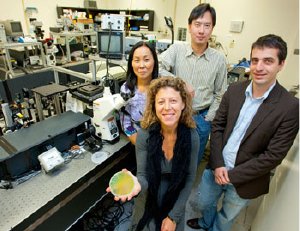Laboratory researchers may have found a way to improve Raman spectroscopy as a tool for identifying substances in extremely low concentrations. Potential applications for Raman spectroscopy include medical diagnosis, drug/chemical development, forensics and highly portable detection systems for national security.
The ability to identify molecules at low concentrations with great specificity and provide non-invasive, nondestructive measurements has led to the increasing use of Raman spectroscopy as an accepted analytical technique. But a shortcoming of this technique has been its lack of sensitivity and reliability at extremely low concentrations.
 From left: Elaine Behymer, Tiziana Bond (seated) and postdocs Allan Chang and Mihail Bora.
From left: Elaine Behymer, Tiziana Bond (seated) and postdocs Allan Chang and Mihail Bora.
Raman spectroscopy consists of observing the scattering of light, usually from a laser, by molecules of a transparent substance. The difference in the wavelength of scattered light and incident light can provide detailed information about the nature of the substance.
"Raman scattering provides a nice fingerprint of materials of interest for national security," said Tiziana Bond of LLNL's Center for Micro and Nano Technology.
Bond and her group develop surface-enhanced Raman spectroscopy (SERS), a method that increases sensitivity orders of magnitude by improving signals. While showing great potential, the substrates used for SERS, typically roughened metal surfaces, have yielded variable signals considered, as yet, unreliable. The roughened surface enhances the interaction of the molecule with the metal. The challenge has been to find a way to create a substrate with uniform topographic features that yield consistent signal enhancements.
Some of this work is described in a paper published in the September 2010 edition of Nanotechnology entitled "Rigorous Surface Enhanced Raman Spectral Characterization of Large-Area, High-Uniformity, Silver-Coated Tapered Silica Nanopillar Arrays," which was published by Bond and her group in collaboration with researchers from the University of Illinois at Urbana-Champaign.
Improved nano-engineering techniques and semiconductor manufacture methods have enabled the production of SERS substrates -- the base layer or texture on 4- to 6-inch wafers -- that are more reliable. The key is substrates with "reproducibility" sufficient for reliable analysis. LLNL researchers have worked on several techniques to achieve a more robust and uniform substrate that maintains high sensitivity and reproducibility.
Electromagnetic and chemical enhancements are two factors that affect SERS total enhancement (with respect to Raman). The first is stronger and accounts for 106-108 magnitude improvements, while the second is typically responsible for 10-100 factors. To exploit the electromagnetic effects, the metallic nanostructures need to be properly designed.
In an article entitled "Plasmon Resonant Cavities in Vertical Nanowire Arrays" published in Nano Letters earlier this year, Bond's group, investigate an innovative design using a vertical a gold-coated nanowire array substrate that would provide strong and controllable enhancement. The LLNL team's innovation is the fabrication of "tunable" plasmon resonant cavities in the vertical wire arrays -- cavities are the space between the vertical wires. Mihail Bora, a postdoc that joined Bond's group a year ago, is heavily involved in this part of the project and explains that surface plasmons are electromagnetic waves similar to light, except they are confined on metallic surfaces. Tuning of plasmon resonance is achieved by controlling the geometrical dimensions of the cavity.
They introduce the smallest optical resonant cavity that is thousands of times smaller than wavelength of light and showed that it is possible to go beyond this diffraction limit by using surface plasmons. Resonant cavities are currently used for surface enhanced Raman spectroscopy to detect chemical analytes (concentration). "By confining the light in such tight spaces we are able to create intense fields that are useful in increasing the spectroscopy signal," Bond said.
These design features offer a number of advantages. For example, it allows the sensitivity of the substrates to be tuned, or adapted, to different wavelengths offering researchers greater versatility.
Among possible application extensions of the plasmonic substrate beyond the enhancement of SERS are enabling the demonstration of sub-wavelength plasmonic lasers, and broadband nanoantenna arrays for photovoltaics by playing with geometry factors.
The group's work has been funded by Defense Advanced Research Projects Agency (DARPA) and LLNL's Laboratory Directed Research and Development (LDRD) program.